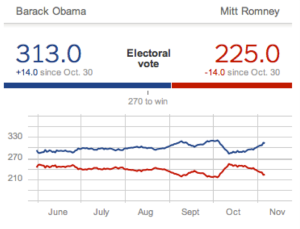Wow, has it really been so long since I posted? I REALLY need to get this hangnail situation under control. Seriously, I need some body butter or some really rich cuticle cream. Something with olive oil.
So, one of the big stories in the aftermath of the recent presidential election, besides the minor sideshow of someone was re-elected, was the utter triumph of Cold Hard Numbers over Gut Feelings. Nate Silver became a veritable It Boy as his blog FiveThirtyEight correctly predicted the totals of the electoral college, including the always-kooky Florida (official state breakfast: the waffle). Other pundits who did a good job of predicting the outcome included Sam Wang of Princeton Election Consortium and Markos Moulitsas of The Daily Kos. And how did they manage this feat? Through the wild method of looking at the polling data. I know, that’s crazy, right? Ask people what they’re going to do and then listen when they tell you.
Now obviously there was a little more to it than that—there was a wealth of polling data available at both the national and state level, and each of these pundits created their own proprietary models that included how reliable they felt the polls were, adjustments for likely turnout, etc. But in general, the models amounted to looking at the data and seeing where it lead. Contrast this with methodology of former Reagan speechwriter Peggy Noonan:
All the vibrations are right… there’s the thing about the yard signs. In Florida a few weeks ago I saw Romney signs, not Obama ones. From Ohio I hear the same. From tony Northwest Washington, D.C., I hear the same.
Is it possible this whole thing is playing out before our eyes and we’re not really noticing because we’re too busy looking at data on paper instead of what’s in front of us?
Turns out this was not possible.
Now, we in California love our vibrations, but in this case the data on paper was the result of calling people and asking them which of a few well-known choices they might make in a week or two. As far as surveys go, it’s pretty damn predictive. And yet a broad swathe of people who didn’t like what the survey results were telling them did whatever they could to instead find an answer they liked better. Dean Chambers created a whole site, UnSkewed Polls, dedicated to the idea that all the polls oversampled Democrats and thus were unrepresentative. He suggested that Nate Silver wasn’t to be trusted because he is “a thin and effeminate man with a soft-sounding voice.” Peggy made her prediction based on vibrations and yard-sign anecdotes. Newt Gingrich was probably just fluffing up the person signing his paychecks.
I get where this comes from. I love numbers, and one of the hardest things to do is to listen to the numbers when they are telling you something you don’t want to hear. This is probably even harder at startups, because the idea of starting a new company is fairly irrational to begin with. So to jump from the mindset of irrationally hoping, working, and striving to rationally assessing a dashboard of numbers, that can be tough.
But if you don’t? Well, you can find yourself putting a lot of time, money and effort into heading the wrong direction.
